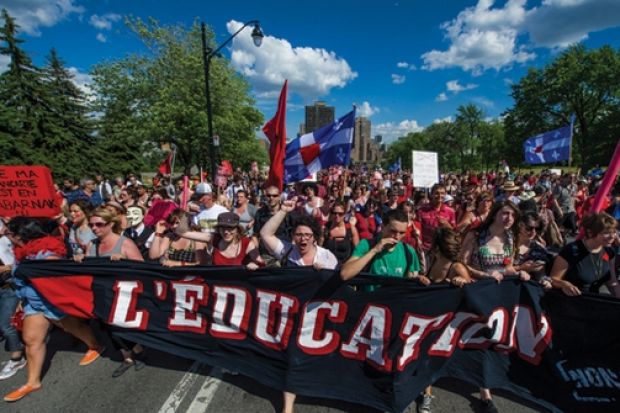Source: Getty
Vive la révolution: student protests in Canada that led to the downfall of a government have inspired some NUS members
The student protest to be held in London next week by the National Union of Students is one that its leadership never wanted.
Union leaders feared that violence could damage the NUS’ standing among voters in the next general election, when unseating deputy prime minister Nick Clegg from his Sheffield Hallam constituency is among the union’s aims.
But the student Left, inspired by the anti-fees protests in Quebec that led to the downfall of the provincial government, is relishing the prospect of the demo on 21 November.
The event was backed by delegates at the NUS conference in April despite the leadership’s opposition. The union’s national executive committee then voted down leaders’ proposals to subsume the demo in the Trades Union Congress’ anti-cuts protest, held last month.
At a meeting of the NUS’ executive committee in July, Liam Burns, the union’s president, did not hide his unhappiness, saying: “I still believe this to have been the wrong decision but it is fair to say that I haven’t seen any great kickback from membership.”
Asked if he was concerned by the possibility of violence on the demo, Mr Burns said: “Yes, it’s a worry. That’s why I’ve been so clear with members that this [violence] is not the way that you’ll engender public sympathy so they vote along our lines at the general election.”
However, Mr Burns believes the demo is “now right” and noted its potential to create “more politicised” students’ union officers.
He added that it was a “starter gun for what we’ll talk about in the general election”. Among its aims, the union wants to unseat “if not all, then key” Liberal Democrat MPs, including Mr Clegg, who backed the NUS pledge at the 2010 election to oppose higher fees and then broke it after forming the coalition.
He said he was glad not to hear of any vice-chancellors criticising the demo, adding that if he did he would have to ask what they were doing to help. “It simply isn’t enough for universities to go into the next general election calling for research funding to be protected. The public value of higher education needs to be put firmly back on the agenda and to do that we need to work together.”
Mr Burns argued that the NUS leadership and the majority of students’ unions are as one on the slogan for the march - “Educate, Employ, Empower” - and in agreement over its route, which will avoid Millbank, home to Conservative Party HQ, which was vandalised by some protesters who broke away from the NUS demonstration against higher fees in November 2010.
But the National Campaign Against Fees and Cuts will be holding a feeder march on 21 November under an alternative slogan: “Tax the rich to fund education”.
Michael Chessum, NCAFC co-founder and a member of the NUS’ executive committee, said that this reflected the union’s policy for “free education” funded through general taxation - a change from its previous graduate tax policy, voted through at this year’s conference.
He also criticised the route of the main march, which ends next to The Oval cricket ground in South London. The 2010 protests led to the “greatest upsurge in [UK] student activism…ever” and “that wouldn’t have happened without Millbank”, said Mr Chessum, elected last week as president of the University of London Union.
He said the lesson of Classe, the Québécois student group, was that “persistent street mobilisation…eventually won”.
Register to continue
Why register?
- Registration is free and only takes a moment
- Once registered, you can read 3 articles a month
- Sign up for our newsletter
Subscribe
Or subscribe for unlimited access to:
- Unlimited access to news, views, insights & reviews
- Digital editions
- Digital access to THE’s university and college rankings analysis
Already registered or a current subscriber? Login
